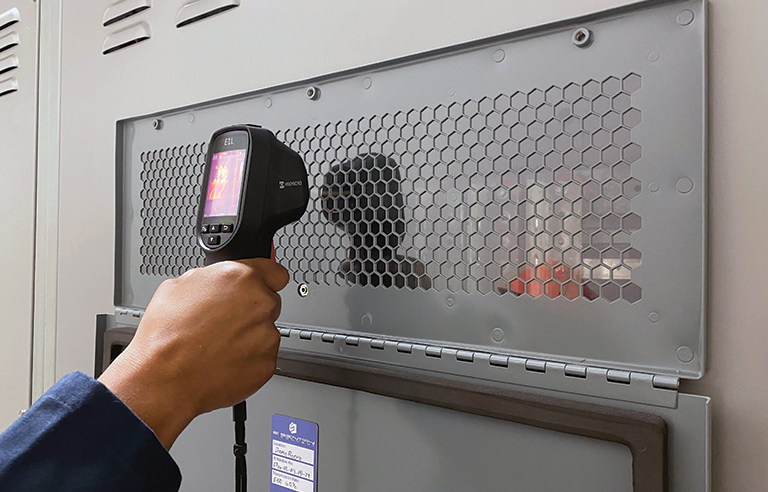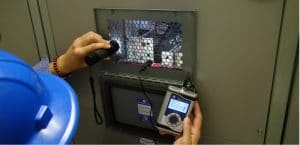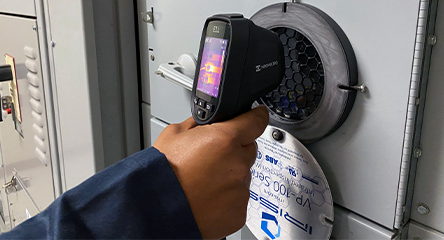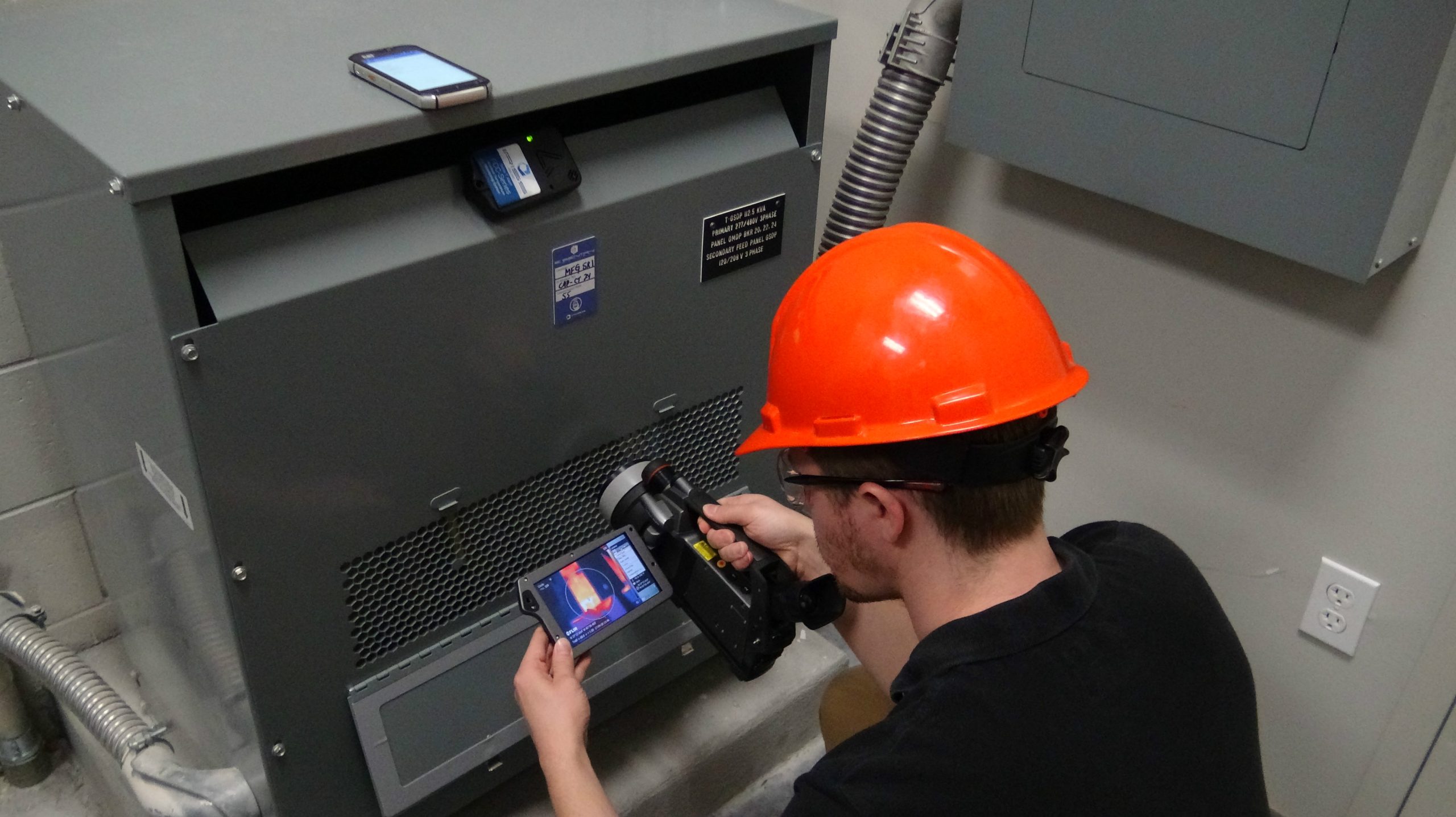Article Archive
IR Inspection Windows – See What You’ve Been Missing
By Michael Riccio, CRL, CSI, ESM, IRT-1
Global Market Manager, IRISS Group

An Infrared Inspection Window is a window that is used to separate environments of differing pressures or temperatures while allowing light energy at a specified electromagnetic wavelength to pass between the two environments. They must meet the strength and environmental requirements for the type of equipment in which they are fitted, as well as be compatible with the infrared inspection equipment being used.
IR Inspection Windows enable the following:
- Collection of real-time, condition status data on critical electrical systems and components
- Mitigates the risk of injury or fatality during inspections because the window maintains an enclosed and guarded condition
- A comprehensive, safe, and intelligent protocol be designed and used for performing essential energized inspections on electrical equipment
What Specifications Must Be Considered When Choosing Infrared Inspection Windows?
IR windows allow infrared cameras to see and measure temperature of objects and connections inside energized electrical equipment with the covers and doors in place (maintaining a safe and guarded condition). IR Windows allow visual, Infrared, and Ultrasound inspections and they provide a safe and cost-effective way to conduct inspections on energized electrical equipment.
- Multi-technology Maintenance Inspection Windows: These windows go beyond just infrared inspection by adding ultrasound capability. In addition to allowing for thermal imaging, visual and UV inspections, ultrasound, and partial discharge inspections can be performed – all from a single window. This approach is cost-effective for the company overall as one type of window can accommodate multiple inspection modalities.

Additional criteria for specifying windows includes:
- Field of View (FOV)- Field of View takes into consideration the viewing angles and distance from the object of the camera and window working simultaneously. Are all the internal objects visible to the camera or is something blocking the camera’s view? The FOV calculation determines the size of inspection window needed for each piece of equipment. When specifying windows on new equipment, make sure to specify the targets you want to be able to see and put the responsibility for selecting appropriately sized windows onto the OEM’s design team.
- Window Design – compliance with flammability, impact and load requirements and OEM specifications for materials and color. The Window cover protects the window itself and the maintenance team.
- Viewing Lens Materials – the lens material must withstand mechanical impact and load requirements with the cover open. The lens must also have a fixed and stable transmission rate for the life of the unit and not change over time. Likewise, the lens material should not change with exposure to humidity or other environmental factors such as vibration. Outdoor lens material should withstand exposure to the sun and not change when exposed to water.
- Certifications Required – Windows, depending on application, may need to comply with multiple certifications such as UL, IP Ratings, CSA for Canada, IEEE Standards for specific equipment types and specialized certification for marine applications such as Lloyd’s of London Approval, ABS or DNV.
- Performance specifications – specify the environment temperature where the Window will reside. Arc Containment testing may be required depending on the application of the Window or switchgear that contains the Window – on new equipment this becomes the responsibility of the OEM as part of their “type testing” protocols. Specify the lens material transmission rate be stable over the window’s operating life. Ensure that the Windows are compatible with all makes and models of IR and ultraviolet cameras. If you choose a Window with IR, Ultrasound and Partial Discharge applications, the Window must be IP2X compliant.

The Business Benefits of IR Inspection Windows
Safety & Standards Compliance
Workplace electrical accidents claim hundreds of lives and cause thousands of serious injuries each year in the United States. OSHA requested that NFPA 70E be created because as new technologies become available it is recognized that most of these fatalities and injuries could be prevented. Hence the publication of NFPA 70E, Standards for Electrical Safety in the Workplace. Maintenance inspection windows with infrared, visual, and ultrasound capabilities are products that fall under the substitution stage in the Hierarchy of Risk Control Methods, Enabling routine and safe inspections of energized electrical assets in a very safe and guarded Condition.
Reliability Improvement, Increased Efficiency & Cost Savings
Historically electrical asset inspections were time consuming, expensive, and potentially dangerous to personnel. Assets had to be powered down, panels had to be removed, personnel had to dress in personal protective equipment, assets had to be powered up and allowed to reach thermal stability. Then thermal imaging and ultrasound data was collected followed by powering down, reinstalling the panels and finally powering back up. Most of the time spent during these inspections was considered nonproductive work adding little or no value.
Maintenance inspection windows dramatically decrease the unproductive time seen with inspections. They provide nonintrusive access to the electrical asset so personnel can perform the inspection in a closed and guarded state eliminating the need for removal and reinstallation of panel covers and the need to wear special PPE.
Case Study:
A regional Power Generation Facility had been tasked by their insurance carrier to perform regular preventive maintenance on the switchgear within their facility. Unfortunately, regular downtime was not a practical option for them as the processes required to do the live inspections were hazardous and required more manpower and resources than they had to provide. In addition, they too were feeling the pressure of the requirements of NFPA 70E and were starting to re-think their strategy since inspections of energized equipment was becoming more restrictive, more time consuming and more costly.
The insurance carrier had done the necessary research and determined that the facility should consider Infrared windows as an alternative method of conducting safer, standards-compliant inspections. Previously, none of the primary switchgear or transformers had been included in the site’s inspections due to the inherent safety hazards associated with their being safely inspected while energized. A review showed that some of the plant’s critical assets were never inspected during the annual survey.
It was determined that a reduction in hazard liability and maintenance costs could be attained through:
- Use of Infrared Windows for routine inspections of healthy equipment did not require the elevated levels of PPE required in 70E, since as stated in 70E 100: “Under normal operating conditions, enclosed energized equipment that has been properly installed and maintained is not likely to pose an arc flash hazard.”
- Maintaining an “enclosed” state for the switchgear, MCC, Transformer, etc., and maintains energized components and circuit parts in a “guarded” condition (in NFPA terms). Therefore, the hazard/risk category would be equal to that of reading a panel meter, using a visual inspection pane for lockout/tagout confirmations, or walking past enclosed, energized equipment and could even be conducted during peak hours for best diagnostic data.
- Use of IR windows would eliminate the need for a supporting cast of electricians to remove and reinstall panel covers.
- Allowing critical personnel to then be available to perform other tasks which were often being outsourced.
- Providing the ability to perform more frequent inspections feasible for critical or suspect applications to ensure plant uptime and appease the insurance carrier of the reduced insurance liabilities.
In search for an alternative approach that was both safer and standards-compliant, the corporate reliability engineer investigated how IR windows be utilized. It was determined that:
- Use of IR windows would provide non-intrusive access to electrical applications. Surveys could be conducted during periods of peak-load without elevating risk to either plant assets or processes. They would also eliminate the need for a supporting cast of electricians to remove and reinstall panel covers. These critical personnel would then be available to perform other tasks which were often being outsourced.
- Use of IR windows and closed-panel inspection would eliminate high-risk tasks during inspections – increasing safety for thermographers. They did not require the elevated levels of PPE required in 70E, since as stated in 70E 100: “Under normal operating conditions, enclosed energized equipment that has been properly installed and maintained is not likely to pose an arc flash hazard.”
- In NFPA terms, an IR window maintains electrical equipment in an “enclosed” state, and it maintains energized components and circuit parts in a “guarded” condition. Therefore, the hazard/risk category would be equivalent to reading a panel meter, using a visual inspection pane for lockout/tag-out confirmation, or walking past enclosed, energized equipment. They would improve inspection efficiency and allow increased inspection frequency for those mission critical or suspect applications.
The new inspection process with IR Windows brought significant ROI to the plant in just two inspection cycles, while reducing the risk of catastrophic failure among the plant’s critical power distribution systems. Management succeeded in increasing safety, facilitating inspections of previously “un-inspectable” equipment, and increasing the frequency of inspection – while saving money. Safeguarding profitability by eliminating high-risk behavior that posed a risk to plant assets and production
Conclusion:

IR Inspection Windows are a Reliability Technology that allows a safer method of monitoring and inspecting critical electrical assets. These should be adopted as part of a comprehensive Condition-Based Maintenance System, where closed-panel inspections can take place with the equipment under full operational load. With the proper procedures in place that take advantage of this technology, technicians can monitor the health of assets and schedule necessary maintenance before an unplanned event occurs, causing costly downtime and possible injury or fatality.
Performing frequent inspections of critical electrical/electro-mechanical assets and performing trend analysis of inspection data over time may pinpoint an asset that is beginning to show signs of deterioration. Once an asset has been identified and a potential failure risk, preventative maintenance can be scheduled and performed. Making use of IR inspection windows increases the company’s asset reliability and minimizes their downtime by scheduling repairs when needed as opposed to when the asset fails.
Advertisement

